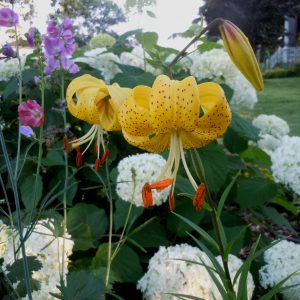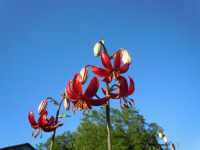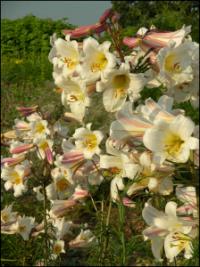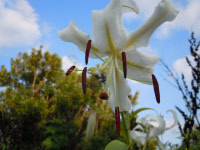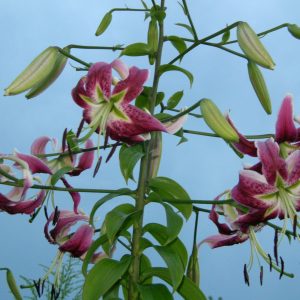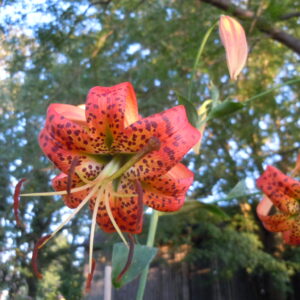Shop
Showing 473–480 of 788 results
-
Lilium leichtlinii Leichtlin’s Lily, Citronella Lily Z 5-9
Up-curved petals on down-facing, yellow flowers freckled with dark spots grace a tall stem with multiple horizontal side shoots, each ending with a flower in June-July.
Up-curved petals on down-facing, yellow flowers freckled with dark spots grace a tall stem with multiple horizontal side shoots, each ending with a flower in June-July.
Size: 3-4’ x 10”
Care: sun to part shade in humus-rich, moist well-drained soil
Native: central Honshu Japan among tall grasses in moist meadowsIntroduced from Japan by the London nursery of Veitch and Sons and described first in Bot. Mag. 93: t. 5673 1867 wherein it was named for German horticulturist Maximilian Leichtlin (1831-1910) He worked at several gardens in Europe then traveled to South America and then founded a botanic garden in Baden-Baden, Germany specializing in bulbous plants. Listed in the 1873 catalog of Leichtlin’schen Gartens in Baden-Baden.
-
Lilium martagon Martagon lily Z 3-8
Usually pink to carmine, smallish downfacing, reflexed petals, with one stem baring up to 50 individual flowers on mature plant.
OUT OF STOCK
Usually pink to carmine, smallish downfacing, reflexed petals, with one stem baring up to 50 individual flowers on mature plant.
Size: 3-6’ x 8-12”
Care: part shade to sun (shorter in sun) in well-drained, lime soil. Resents being moved & often will not emerge in 1st year.
Native: Eastern France to Korea.
Awards: Royal Horticultural Society Award of Merit; Elisabeth C. Miller Botanic Garden Great Plant Pick.The name Martagon means cap in Turkish from the style of turban adopted by Turkish ruler, Sultan Mohammed, which was known as a martagon and had a similarly pendulous shape. Described by English herbalist Gerard (1545-1612) in 1596.
-
Lilium michiganense Michigan lily Z 4-8
The top of each erect stem curves over like a hook. A single red or orange flower dangles from the stem’s tip. Spotted petals (botanically called tepals) curve up with their tips nearly reaching the top of the flower. Stamens hang down from the center then flare out inviting bees and butterflies to its pollen. They flower for nearly a month in mid-summer.
OUT OF STOCK
The top of each erect stem curves over like a hook. A single red or orange flower dangles from the stem’s tip. Spotted petals (botanically called tepals) curve up with their tips nearly reaching the top of the flower. Stamens hang down from the center then flare out inviting bees and butterflies to its pollen. They flower for nearly a month in mid-summer.
Size: 2-5’ x 8-10”
Care: sun to part-shade in moist to moist well-drained, neutral to acidic soil.
Native: New Hampshire west to Wisconsin, south to Arkansas, east to Alabama and Florida
Wildlife Value: attracts hummingbirds, bees, and butterfliesThis had several prior names, as varieties or subspecies of Lilium canadense or Lilium speciosum. In 1915 botanist Oliver Atkins Farwell (1867-1944) renamed it in “Notes of Michigan Liliaceae,” Bulletin of Torrey Botanical Club 42, p. 353, based on one he collected in 1910 in Wiard’s Crossing, Michigan.
-
Lilium regale Regal lily Z 4-8
Midsummer, white trumpets flushed with purple, very fragrant
ARCHIVED
Note: This is a plant not currently for sale. This is an archive page preserved for informational use.
Midsummer, white trumpets flushed with purple, very fragrant
Size: 4-6' x 12"
Care: Sun, moist well-drained soil
Native: Western China
Awards: England’s Royal Horticultural Society Award of MeritLilium was named for the Greek word for smooth, polished referring to its leaves. Ernest Henry “China” Wilson discovered the Trumpet lily when he came upon the Min River valley floor covered with the flowers in bloom, “(n)ot in twos and threes but in hundreds, in thousands, aye, in tens of thousands.” Wilson 1917 Carrying the bulbs out he broke his leg while walking on a narrow mountain trail due to an avalanche. Continuing on the trail Wilson encountered a donkey train coming toward him. To allow the donkeys to pass, he laid down on the trail and let the donkeys step over his body. He walked with a limp the rest of his life, referred to as his “lily limp.” He sent the bulbs to his patron, the Veitch nursery in England.
-
Lilium speciosum album Showy lily Z 4-9
Large, nodding flower heads with recurved petals white, glowing pinkish in August, fragrant.
ARCHIVED
Note: This is a plant not currently for sale. This is an archive page preserved for informational use.
Large, nodding flower heads with recurved petals white, glowing pinkish in August, fragrant.
Size: 3-4’ x 12”
Care: Sun to part shade in moist, acidic soilLilium was named for the Greek word for smooth, polished referring to its leaves. This species introduced to Europe by Carl Peter von Thunberg around 1777. Von Thunberg (1743-1828), student of Linnaeus at Uppsala University in Sweden. He made three trips to the Cape of Good Hope 1772-1775 where he collected about 1000 new species, Java and Ceylon (Sri Lanka) 1777 and 15 months in Japan (1775-1777) where he befriended local doctors who gave him hundreds of plants new to Western horticulture. He succeeded Linnaeus as professor of medicine and botany at Uppsala. Knighted by Swedish King Gustav. Grown at America’s 1st botanic garden, Elgin Botanic Garden 1811. L.H. Bailey (1935) highly recommended this lily as “(o)ne of the most beautiful and satisfactory of all lilies, robust, permanent (and) easily grown…”
-
Lilium speciosum rubrum Z 4-9
Fragrant, deep pink spotted blossoms with recurved petals in late summer
ARCHIVED
Note: This is a plant not currently for sale. This is an archive page preserved for informational use.
Fragrant, deep pink spotted blossoms with recurved petals in late summer
Size: 3-4’ x 12”
Care: Sun to part shade in moist, acidic soil
Native: part of China & southern JapanLilium was named for the Greek word for smooth, polished referring to its leaves. Englebert Kaempfer, first physician to the Dutch East India Co. on Deschema Island (1690’s) described Lilium speciosum in his writings, published in 1712. Introduced to Europe by Siebold and to England in 1832. The English periodical Botanical Register described it: “surely if there is anything, not human, which is magnificent in beauty, it is this plant.” In 1896 the Wisconsin Horticultural Society praised this lily as deserving “…a prominent place in every garden…an old standard lily, as far back as our memory goes.”
-
Lilium superbum Meadow lily Z 4-8
Brilliant orange with purple spots, Turks’-cap type, reflexed petals (tepals), blooming in late summer to early fall.
Brilliant orange with purple spots, turks-cap lily with dramatic, swept-back petals blooming late summer to early fall. Slow to mature but when it does it bears up to 40 flowers on one plant.
Size: 10’ x 12”
Care: Sun in moist to moist-well-drained, acidic soil
Native: from VT to Fl & west to Mississippi River, Wisconsin nativeLilium was named for the Greek word for smooth, polished referring to its leaves. This collected before 1665. In his 1665 book, Flora, seu de Florum Cultura John Rea, nurseryman and author, called it the “Virginia Martagon.” Sold in America’s 1st plant catalog, Bartram’s Broadside, 1783. L.H. Bailey (1913): “The most magnificent and showy of native North American species, well worthy of extensive cultivation.”
-
Limonium latifolium syn. Limonium platyphyllum Sea lavender, Statice latifolia Z 2-8
Airy lavender blue panicles from mid to late summer. Leathery foliage turns reddish in fall. Excellent cut or dried flowers.
OOS
Airy lavender blue panicles from mid to late summer. Leathery foliage turns reddish in fall. Excellent cut or dried flowers.
Size: 24-30” x 24”
Care: Full sun in well-drained soil
Native: Russia, Bulgaria & Romania
Wildlife Value: Deer resistant.Limonium is Greek meaning “meadow” and latifolium means “wide leaf”. This was identified by Dioscorides in De Materica Medica for medicinal use around 70 A.D. Cultivated in gardens since 1700’s. Formerly used to repel moths and cure canker sores.

